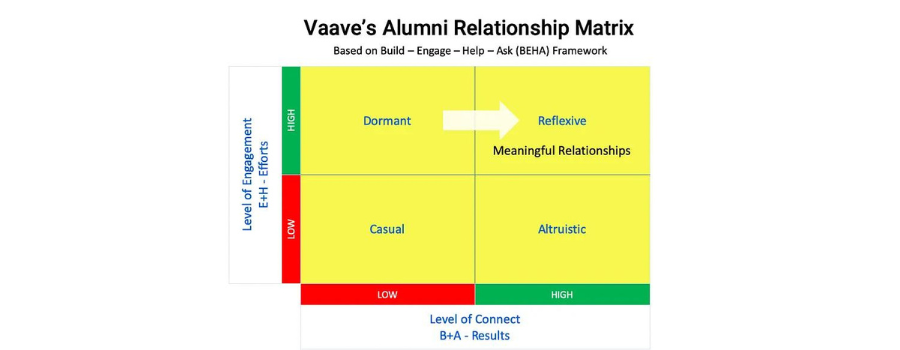How is your relationship with your Alumni?
The balance between give and take makes any relationship healthy and the same applies to Managing Alumni Relations. Here at Vaave, we have worked on understanding the basic essence of it and we created our very own BEHA (Build-Engage-Help-Ask) Framework. The Alumni Relationship Matrix is a measure for us to understand the outcome of the BEHA Framework, a measure to understand the relationship an institution shares with its alumni.
The Alumni Relationship Matrix
This matrix is created based on considering two factors:
Level of Engagement (E+H Efforts) and Level of Connect (B + A Results).
On the vertical axis is the level of engagement, The efforts the institution has put in to actively engage its alumni community i.e. a) the engagement programs being run & b) the initiatives to help alumni.
On the horizontal axis is the Level of Connection the institution finds with the alumni — how strong is the connection? The factors that indicate the results are a) How well is the alumni network built? b) How responsive are alumni to any initiatives of the institution (Ask)?
With reference to the above matrix, the relationship between alumni and institutions is classified as below:
a) Casual: As the name implies, it is a very casual relationship where neither the institute nor the alumni community is keenly engaged with each other. This is the stage where the build, contribution, effort, and help on the engagement is low. This indicates your database and effort from the institute needs special attention.
b) Dormant: In the second stage, the efforts from the institute to engage its alumni are high but the result is not as expected as it should be in the contribution and database building. This is the stage where the alumni engagement activities are initiated from the institute’s end but a small resistance from the alumni prevails. Why is the level of connection from the Alumni Network low despite a lot of efforts from institutes? Most of the institutions fall under this category
c ) Altruistic: In this stage, Institutional efforts are very low but the engagement strategies are high. For example, we have found that fundraising happens across top brands like IIT and IIM institutes where the contribution from the alumni is more but institute-level effort is very low. But, Is having a one-sided level of connection good for building long-lasting alumni relationships? Absolutely Not, the Ideal state is the “reflexive” state.
d) Reflexive: This is the final and the best stage to be in, where the institute puts effort and the alumni contribution is equally high. This is the stage where all the institutes should be targeted. Here the give-and-take relationship exists in a very meaningful way.
Meaningful engagement is what makes the relationship move from a dormant to a reflexive state. But keeping all the different personas of each category, it is important to customize the engagement activity for each category of the alumni. Now the next question we arrive at is, How to engage alumni meaningfully based on their interests? We have come up with strategies and ideas that would work according to individual institutions. For some institutes, reunions and meetings will have a great impact and for some, it would be the alumni services.
Gain an insight from the CEO’s view point in this video –
Let us know how is your relationship with your Alumni! Reach us at hello@vaave.com






